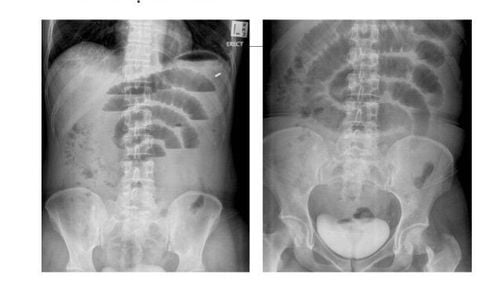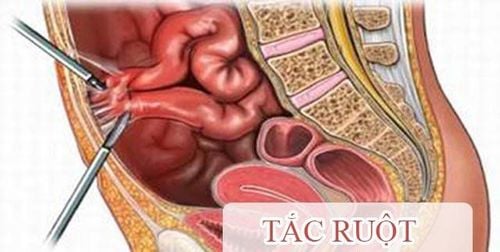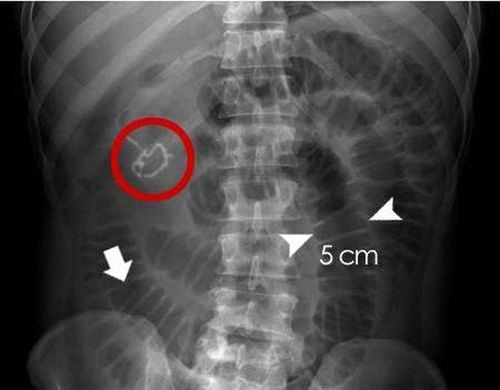This is an automatically translated article.
The article is professionally consulted by Master, Doctor Nguyen Van Huong - Department of Diagnostic Imaging - Vinmec International General Hospital Da Nang.Small bowel radiographs are one of the few means of imaging the small intestine. To make the picture clearer and easier to see, small bowel radiographs can be used along with contrast material. When barium sulfate coats the wall of the small intestine, X-rays pass through the soft tissues, creating images that light up and allow problems in the small intestine to be detected.
1. What is a small bowel X-ray?
When patients are admitted to the hospital with symptoms of suspected small bowel disease, such as abdominal pain or vomiting, small bowel radiography is one of the few imaging modalities available in this organ. There are two types of radiographs of the small intestine: upright, unprepared, and contrast-enhanced.For radiographs of the small intestine in unprepared straight abdominal radiographs, this is a first-line clinical indication because it is easy, quick, and widely available. In most cases, abdominal radiographs will have features suggestive of small bowel obstruction, which are dilated loops of small bowel proximal to the obstruction, dilated loops of bowel centrally with The diameter of the intestinal loop is dilated from over 2.5 to 3cm, the small intestinal folds are observed, running around the circumference of the intestine, the water level is slightly located in the center and the "string of pearls" sign is of the nature. are small air sacs in the intestinal wall when the lumen of the small intestine is filled with fluid that accumulates due to an obstruction.
For small bowel radiographs with contrast, this medium is used to evaluate chronic small bowel lesions. Before the procedure, the patient is given a liquid containing barite or iodinated contrast agent, which enhances the X-ray image. As the contrast material moves from the stomach into the lumen of the small intestine, the radiologist uses an X-ray machine to examine this part of the organ. During that procedure, the patient may be asked to rotate their body position on the imaging table to coat all surfaces of the small intestine with contrast.
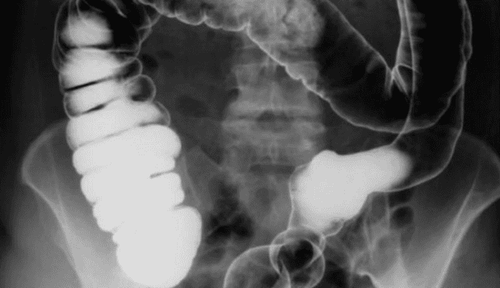
2. Indication for X-ray of the small intestine with contrast material
Compared with small bowel radiographs in unprepared straight abdominal radiographs in the setting of bowel obstruction, contrast-enhanced small bowel radiographs are performed to evaluate the small intestine in chronic conditions. This is when the clinician suspects abnormalities in the size and shape of the small intestine, lesions in the intestinal mucosa, and evaluates how the substance moves in the lumen when these goals are very difficult to achieve. with other imaging modalities, including endoscopy.Thus, a small bowel radiograph with contrast is used to diagnose conditions such as:
Crohn's disease Semi-obstructive small intestine Inflammatory bowel disease Abnormal polyps or masses Small bowel cancer Related complications to abdominal or intestinal surgery
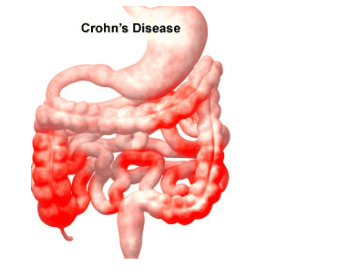
3. How is X-ray of the small intestine with contrast done?
Preparation Patients should inform their physician of any medications they are taking and if they have a history of allergies, especially to iodinated contrast agents. Also let your doctor know about recent co-morbidities or other medical conditions.Women should always notify their doctor and radiologist if there is a possibility that they are pregnant. Many imaging tests are not done during pregnancy so as not to expose the fetus to radiation. If X-rays are necessary, precautions will be taken to minimize the risk of radiation exposure to the fetus.
In addition, the patient will also be given detailed instructions on what can and cannot eat or drink the day before the scan and not eat or drink for several hours before the procedure. Patients may be prescribed laxatives to help improve the appearance of the digestive tract.
Before the procedure, the patient will be asked to remove the clothes they are wearing and change into a specialized gown. The patient may also be asked to remove jewelry, removable dental instruments, eyeglasses, and any metal objects or clothing that may interfere with the X-ray images.
Procedure Before starting, the patient will be given two or more large cups of contrast medium. Contrast is taken as a solid, milky white drink or clear liquid, often flavored to make it more palatable. However, some people with sensitive skin may experience bloating and nausea when taking it.
Then, the technician will arrange the patient to lie on the X-ray table and place the X-ray machine above the abdomen. At this time, the person may also be given some lead shielding to help protect certain parts of the body that are more susceptible to X-rays.
Once the contrast medium has reached the small intestine, the radiologist will observe its flow through the enlarging screen. Local radiographs will be performed if there are abnormalities that require further analysis.

In some cases, the patient will need to continue to drink an additional amount of contrast medium during the procedure to ensure that the radiologist can fully examine the entire length of the small intestine.
The test time depends on how long it takes for the contrast medium to travel from the stomach to the large intestine. Therefore, the procedure can take about one to two hours, but in some patients, it can take longer or twice as long.
Ending The patient can completely return to normal activities and eating right after taking X-ray of the small intestine with contrast.
It should be noted that stools may be slightly white in the first few days or may be constipated. It's important to drink plenty of water to help flush any remaining barite from the digestive system.
4. What are the benefits of having a small bowel X-ray?
Abdominal X-ray is a completely non-invasive test. Despite the use of contrast-enhanced small bowel radiographs, it is a minimally invasive, painless procedure with rare complications.Therefore, radiographic examination may be informative enough to avoid the need for more invasive procedures. In particular, a small bowel radiograph in an unprepared straight abdominal radiograph helps to find additional evidence supporting the diagnosis of bowel obstruction; Contrast-enhanced small-bowel radiography has a role in the evaluation of chronic diseases, when abnormalities in the size and shape of the small intestine are suspected, lesions on the intestinal mucosa, and in assessing how transfer in the intestinal lumen.
Compared with contrast agents that enter the body through the bloodstream, drinking barite solution is generally safer, although it can cause constipation a few days later.
In summary, small bowel imaging with small bowel radiography is a common, easy-to-implement procedure with this relatively inaccessible direct gastrointestinal tract. Small bowel X-ray showed the possibility of small bowel obstruction when the patient was admitted to the hospital because of acute abdominal pain with vomiting; Commonly used in conjunction with contrast media to diagnose abnormalities of the small intestine, such as small bowel tumors, ulcers and other inflammatory conditions, polyps, hernias, and general chronic strictures.
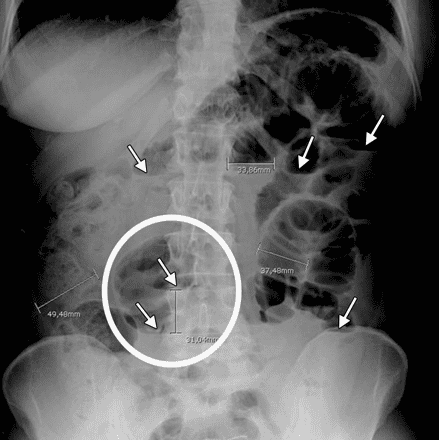
Please dial HOTLINE for more information or register for an appointment HERE. Download MyVinmec app to make appointments faster and to manage your bookings easily.







